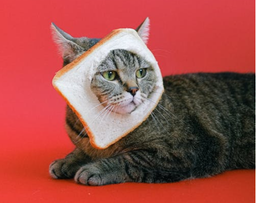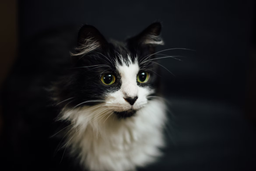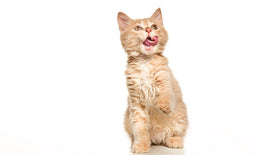Can cats eat raw meat? Bone up on the dos and don’ts of the feline diet with Untamed!
Cats are natural predators following an exclusively carnivorous feeding pattern. Even after domestication, they’ve preserved their killer instinct, hunting various pests, such as mice, insects, and even snagging an occasional bird.
Because of the felines’ biological disposition, you’d think feeding them meat right off the bone is the ultimate diet. But can cats eat raw meat, or does it pose a threat to their health? Let’s explore the potential risks of giving your pet uncooked and unprocessed ingredients! We’ll even throw in a few pointers for making tailor-made treats for your feline companion!
Should cats eat raw meat?
Many cat parents believe the only way to cater to the feline’s carnivorous nature is to feed them the bones and raw foods (B.A.R.F.) diet. While it’s true that cats get all the essential nutrients from freshly killed prey in the wild, giving undercooked or unprocessed meat to your pet can be pretty dangerous.
So, can you feed cats raw meat? The short answer is—no. Raw food, such as meat, eggs, and unpasteurised milk, contains pathogens detrimental to your cat’s health. The trifecta of harmful bacteria commonly found in unprocessed food includes:
- Salmonella
- Listeria
- E. coli
Salmonella
Salmonellosis is a disease caused by a particular type of Salmonella bacteria found in raw meat, such as pork, beef, chicken, and fish. The infection is easily spread from cats to humans, posing an imminent risk to the entire family. Your cat can contract the bacteria in two possible ways:
- Consumption
- Cross-contamination (exposure to contaminated surfaces/objects)
The symptoms of salmonellosis are similar to those of food poisoning or gastrointestinal disease (e.g., irritable bowel syndrome). If the feline is exposed to the bacteria, they’ll have the following symptoms in the next 12–72 hours:
- Vomiting
- Diarrhoea
- High fever
- Loss of appetite
- Lethargic behaviour
Diagnosing the disease early on is vital since salmonellosis can be lethal when left untreated. Felines with a weakened immune response or chronic illness are at a higher risk, along with kittens and senior cats.
If you suspect your pet has contracted the bacteria, take them to the vet. They will perform a series of tests to exclude similar diseases, such as listeriosis or bacterial gastroenteritis, so they’ll most likely collect blood, urine, and faecal samples.
The treatment for salmonellosis includes antimicrobial medication and food restrictions within 48 hours after the initial diagnosis. You’ll have to ensure your pet gets enough fluids and electrolytes to compensate for the loss. In more severe cases of acute salmonellosis, some cats may need blood transfusions.
Listeria
Cats can contract listeriosis by eating undercooked meat, uncooked seafood, unpasteurised dairy products, cold leftovers, and garbage. Listeria monocytogenes is a particularly harmful bacteria known to cause early death in felines and humans. It’s not as common as salmonella, but it’s more likely to result in hospitalisation.
Unfortunately, cats can carry the bacteria for weeks without showing any symptoms or developing the disease. Listeria attacks multiple tissues, so the time between contamination and developing listeriosis can vary. The symptoms are also different depending on the affected area, but primarily include:
- Vomiting and nausea
- Diarrhoea
- Fever
- Appetite loss
- Muscle stiffness
- Facial paralysis
- Lethargy and weakness
Listeria is incredibly dangerous for pregnant women, newborns, seniors, and people with compromised immunity. Make sure to keep track of your cat’s behaviour and be extra vigilant when handling raw meat. As soon as you notice the symptoms mentioned above, take your feline to the vet for further testing.
The treatment can vary based on the clinical symptoms. It mostly entails antibiotics, anti-inflammatory medication for the stomach, and short-term dietary restrictions. In more severe cases, when Listeria monocytogenes makes it to the feline’s brain, vets opt for more aggressive treatment.
E. coli
Like in most mammals, E. coli is already present in the cat’s lower gastrointestinal tract as part of the gut flora. Issues arise when the bacteria enters a part of the body unequipped to host it or when the feline consumes a harmful strain of E. coli.
Adult cats with stable health are less susceptible to E. coli than kittens and senior cats. Nursing kitties are likely to contract the bacteria from their mom’s milk and develop a disease called colibacillosis.
Pathogenic E. coli is present in raw or undercooked meat and unpasteurised dairy. Once the harmful strain enters the feline’s organism, it can cause several health problems, particularly urinary tract infections and digestive tract disease. The symptoms vary depending on the affected body part but typically include:
- Vomiting
- Fever
- Decreased appetite
- Diarrhoea and bloody stool
- Tender abdomen
- Frequent urination
Diagnosis requires a series of lab tests, including blood work, urinalysis, faecal exams, and ultrasound. If your suspicions are confirmed, the vet will most likely prescribe a full course of antibiotics (ten to 14 days). Besides medication, you’ll have to monitor your cat’s temperature and make sure they get enough fluids.
Can kittens eat raw meat?
Because they’re still developing, kittens are especially susceptible to bacterial infections and should steer clear of raw meat! Salmonellosis and listeriosis can be lethal to kittens because of their weakened immune response.
It’s not uncommon for kittens to contract pathogenic E. coli in their first few weeks and develop a disease called colibacillosis. The contamination can occur in utero, during birth, or while nursing and can manifest in the following symptoms:
- Vomiting
- Lethargy
- Appetite loss
- Extreme diarrhoea
- Low temperature
- Severe dehydration
Before they start eating solids, kittens feed exclusively on their mother’s milk, so that’s when you should look for signs of colibacillosis. A kitten milk replacer formula will do the trick if the cat mother isn’t around. Don’t give them cow milk or any other variant (especially unpasteurised milk) since they won’t be able to digest it.
What should kittens eat when they start weaning? The fur babies require a well-thought-out meal plan that’ll cater to their energetic and nutritious needs. You want to give them enough calories to sustain their shenanigans but maintain a healthy weight. Ideally, each portion should contain the following nutrient ratio:
|
Nutrient |
Recommended amount |
|
Protein |
Over 50% |
|
Fat |
Up to 20% |
|
Calcium |
Less than 3% |
You can get them started on a balanced diet of baby food and KMR and monitor their progress. Once they’re around 12 months old, you can gradually switch to adult cat food.

“I'm brushing up on looking down; I'm working on my ROAR”—easy now, Simba, you’re too young for a lion’s diet!
Source: Leuchtturm81
If feeding raw meat to cats is dangerous, what’s a safer alternative?
An entirely raw diet is far too risky for the pampered indoor cat. The amount of potentially harmful bacteria contained in each serving of unprocessed food outweighs the nutritional benefits.
If you want to provide your cat with proper nourishment and maintain their health, you can prepare the food yourself or use commercial cat food.
Making homemade meals sounds cosy, but make no mistake—it’s time-consuming and challenging. You’d have to study up on cat nutrition (what they eat, when to feed them, and in what amounts) and ensure your pet gets all the essential micronutrients with each serving.
The most practical option for modern-day felines and their caretakers is a diet consisting of high-quality wet food. Semi-moist and wet food products are designed to meet your cat’s unique biology, which is why both variants are:
- Rich in moisture—Dehydration is a serious issue, causing several uncomfortable health conditions, such as feline constipation. Wet cat food typically contains 78% moisture, ensuring their water intake is optimal
- High in protein—High-quality products are made with animal protein, which provides essential amino acids your cat’s body can’t produce. Taurine is crucial for their heart, brain, and eye function
- Low in carbs—Besides being unnecessary, carbs can also be harmful to your cat. The feline metabolism isn’t designed to process the macronutrient, which is why most top-shelf brands keep their carbohydrate contents below 10%
- Filled with vitamins and minerals—Vitamin B, potassium, zinc, magnesium, and other vitamins are vital for your cat’s metabolism. Most manufacturers artificially add the minerals to the food, so there’s no need for dietary supplements. You risk the formation of struvite crystals and cystitis if you go overboard
Kibble is the other widespread type of commercial cat food, and one could say it’s the antithesis to raw diets because of the way it’s produced. Dry food is made with a mixture of meat, veggies, and grain, which is then heavily processed. The result is high-calorie, dry kibble.
Most vets agree a dry-food-only diet is not the best regimen for felines, especially certain breeds prone to diabetes, like Maine Coons, Siamese, and Burmese cats. While high-calorie food works well for malnutrition recovery and is said to prevent dental disease, it should only be used in combination with wet food.
Untamed food—the best choice for your feline companion
If you want to treat your feline companion to nourishing and delicious meals, try Untamed! Our recipes are carefully designed to resemble the feline ancestral diet, minus the nasty microbes that can compromise your cat’s health.
Each meal is:
- Full of protein—The protein content in a single serving of Untamed food is twice the industry standard. We don’t use plant protein, meat derivatives, or other useless or harmful substances—only the best animal protein for our feline delicacies
- Made with whole meat—We use premium meat cuts in our tasty and nourishing recipes. Each ingredient is of human-grade quality, and the final product is packed with bioavailable nutrients your cat needs to stay healthy
- Vet-formulated—Veterinarians designed our meals to meet your cat’s unique biological needs. Each serving is nutrient-dense and free of all known allergens
- Ethically produced—When we say we care about creating a better world for our feline friends, we mean it! Untamed packaging is recyclable. We get our ingredients from sustainable sources and leave a neutral carbon footprint
- Impossible to resist—Untamed meals are as tasty as they are nourishing. Watch your fussy eater twist their whiskers in anticipation when you open a tin of our gourmet cat food
We gently steam all our meals to make sure the original bioavailability of the ingredients is preserved during production. Because we don’t over-process our food, your cat will start feeling the Untamed effect soon after finishing their first dish! Here’s a breakdown of the short- and long-term health benefits our diet can provide:
|
Timeline |
Health benefits |
|
Within a week |
|
|
After two months |
|
|
Within four months |
|
|
Life-long benefits |
|
Check out our delicious recipes!
Untamed food is made with premium, ethically-sourced meat, such as:
- Chicken breast and liver
- Duck breast
- Tuna steak
- Salmon fillet
- Sardine and mackerel fillet
Every dish is irresistible to cats of all ages and breeds! The most popular products include:
- Chocka Chicken in Jelly—Extra moist chicken breasts soaked in jelly and light on the tummy
- Tuck-in Tuna in Jelly—Cruelty-free tuna simmered in jelly and hearty fish broth
- Chocka Chicken with Duck in Jelly—The ultimate poultry platter, high-quality chicken breast mixed with whole duck meat, served in jelly
- Tuck-in Tuna with Salmon in Jelly—Delicious whole meat tuna soaked in jelly and served with high-grade salmon fillet
- Chocka Chicken in Gravy—A delicious dish for the sensitive feline, made with shredded chicken breast and steamed in natural gravy
Take the Untamed online quiz to determine the best diet for your feline companion!

Untamed’s Tuck-in Tuna in Gravy will satisfy your cat’s inner hunter without compromising their health!
Image (c) Untamed
How do I become a member of the Untamed community?
If you want to ensure your pet pantry is always filled with nourishing meals, join our proud clowder! We have the best online cat food store—here’s how to sign up for a tester pack and treat your cat to Untamed’s gourmet recipes:
- Visit our Try Now page
- Tell us about your cat
- Select a meal plan and place the order
We'll deliver your custom-made meal box within a day, with no additional shipping fees! Once your cat samples everything, you'll start receiving a delicious cat food box every month, and you can modify your meal selection anytime.
If you want to alter or cancel your order for any reason, you may do so from your account.

Oh my, this smells delicious. Great catch, mom!
Image (c) Untamed
Can cats eat raw hamburger meat?
Ground beef is a popular treat among pet parents due to its adequate protein content (14 g per 100 g). But can cats eat raw minced beef, or is it a health risk?
While feeding cats raw beef is not as dangerous as giving them raw pork, for example, it’s still not something you should do regularly. The pathogens contained in uncooked hamburger meat, such as listeria and salmonella, can damage your cat’s gastrointestinal tract and possibly lead to hospitalisation.
Besides the harmful bacteria, beef is not the best snack because of its high fat content. A 100 g of minced beef contains 30 g of saturated, monounsaturated, and trans fats, which is above the recommended daily intake.
While animal fat is one of the essential nutrients in the feline diet, along with protein, vitamins, and minerals, overconsumption can lead to several short- and long-term health issues, such as:
- Heartburn
- Indigestion
- Diarrhoea
- Heart disease
- Obesity
The 30% fat content in ground beef is more than your feline’s needs. Cats should have less than 20% fat in their diet regardless of their breed or size.
More dos and don’ts of the feline diet

The key to your cat’s health is gently cooked protein-packed snacks!
Image (c) Untamed
If cats and raw meat don’t mix, what are other nutritional no-nos you should know about? Our feline friends are hard-wired carnivores, so numerous food items could harm them. Check out forbidden food in the list below:
- Milk—Most cats are lactose intolerant, so refrain from feeding them dairy products like milk, cream, and cheese. It’s okay to give them a sip of yoghurt and lactose-free milk, but keep it at a minimum
- Raw bones—Raw bones are a choking hazard! As your cat nibbles on the brittle bone, tiny shards can break off and lodge in their throat. Even if they swallow it in one piece, the bone can cause internal damage
- Allium—Onions, garlic, chives, and shallots cause kidney disease in cats. The allium attacks the red blood cells leading to anaemia and other chronic conditions
- Grapes and raisins—Grapes are toxic to cats and can disrupt their kidney function. If your pet ate dried or fresh grapes, they’ll most likely suffer from vomiting, diarrhoea, abdominal pain, and decreased urination in the following 12 hours
- Raw dough—When travelling through the feline’s gastrointestinal tract, the raw dough can ferment and even produce alcohol because of yeast. Make sure to thoroughly clean your kitchen and utensils after making bread
- Processed meat—Ham, salami, bacon, and other charcuterie delicacies contain too much sodium and fat for your feline companion. Besides causing an upset tummy, processed meat can lead to heart disease, hypertension, and severe dehydration in the long run
Wait, if milk and bones are off-limits—what do I do when my cat gets the munchies? As a rule, complementary food shouldn’t take up more than 3% of the feline diet. When you treat your pet, make sure to give them something substantial. You can let them snack on high-fibre veggies and fruits, such as strawberries, watermelon, bananas, pumpkin, and apples, to encourage regular bowel movement but keep it occasional.
Naturally, the best treats are those packed with animal protein! Here’s a shortlist of the healthiest (and tastiest) meat snacks for your little carnivore:
- Turkey
- Chicken
- Liver
- Scallops
- Mussels
- Clams
- Carp
- Salmon
- Cod
- Tuna
- Prawns
Check out our other guides to what cats can or cannot eat:
|
|

![Best food for Ragdoll cats in the UK [Broken Down]](http://untamed.com/cdn/shop/articles/featured_best_food_for_ragdoll_cats_uk.jpg?v=1646818249&width=256)

